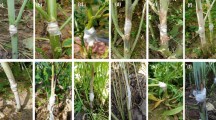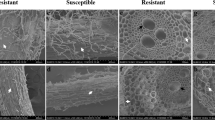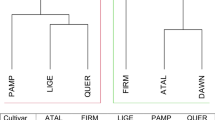Abstract
Yellow stem borer (YSB) is a serious pest of rice throughout the year in Asia and causes 40–50% yield loss. Screening genotypes and breeding resistant varieties are effective strategies for its management. The present study demonstrates the importance of ultrastructural and morpho-anatomical features of rice stem that confer resistance to YSB. A total of 188 rice genotypes were evaluated for dead heart and white ear damage of YSB. The crop booting stage of 113 genotypes coincided with peak YSB invasion. Forty-five days after transplanting (DAT), dead heart damage was recorded and 17 genotypes were found to be resistant. However, only one genotype, RG109, exhibited resistance based on white ear damage at crop maturity. Six genotypes selected based on dead heart damage were characterized for stem features using scanning electron microscopy, and their defense response against YSB was explored. Among the six genotypes, RG109 had a greater number of vascular bundles, density and width of silicified microstructures (SMS), and the density of trichomes. The elemental silica content inside and outside of the stem was mapped with SEM-supported energy-dispersive X-ray spectroscopy and found that RG109 had a higher silica content (17.85%) than the susceptible control, TN1 (1.12%), in the outer stem. Similarly, the adaxial side of the leaf blade and aerenchymatous region of the stem were studied extensively between the resistant (RG109) and susceptible (TN1) genotypes, further reiterating the differences in resistance level. Hence, surface morphological structures such as trichomes and SMS, their spatial distribution pattern and the elemental silica content hindered larval feeding behavior, which facilitates host plant-mediated YSB management in rice cultivation.
Graphical abstract









Similar content being viewed by others
References
Bandong JP, Litsinger JA (2007) Rice crop stage susceptibility to the rice yellow stemborer Scirpophaga incertulas (Walker) (Lepidoptera: Pyralidae). Int J Pest Manag 51(1):37–43. https://doi.org/10.1080/09670870400028276
Bhatt N, Joshi S, Tiwari SN (2018) Pests of rice. In: Omkar (eds), Pests and their management, pp 9–50. Springer, Singapore. https://doi.org/10.1007/978-981-10-8687-8_2
Bowden J (1976) Stem borers ecology and strategy for control. Ann Appl Biol 84:107–111
Chandramani P, Rajendran R, Muthiah C, Chinniah C, Hinniah C (2010) Organic source induced silica on leaf folder, stem borer and gall midge population and rice yield. J Biopesticides 3:423–427
Chandramohan N, Chelliah S (1983) Rice resistance to yellow stem borer. Intern Rice Res Newsl 8(2):8
Chen KC, Lin CY, Kuan CC, Sung HY, Chen CS (2002) A novel defensin encoded by a mungbean cDNA exhibits insecticidal activity against bruchid. J Agric Food Chem 50(25):7258–7263. https://doi.org/10.1021/jf020527q
Deka S, Barthakur S (2010) Overview on current status of biotechnological interventions on yellow stem borer Scirpophaga incertulas (Lepidoptera: Crambidae) resistance in rice. Biotechnol Adv 28(1):70–81
Devasena N, Soundararajan RP, Reuolin SJ, Jeyaprakash P, Robin S (2018) Evaluation of rice genotypes for resistance to yellow stem borer Scirpophaga incertulas (Walker) through artificial screening methods. J Entomol Zool Stud 6(1):874–878
Dorairaj D, Ismail MR (2017) Distribution of silicified microstructures, regulation of cinnamyl alcohol dehydrogenase and lodging resistance in silicon and paclobutrazol mediated Oryza sativa. Front Physiol 8:491. https://doi.org/10.3389/fphys.2017.00491
Han Y, Lei W, Wen L, Hou M (2015) Silicon-mediated resistance in a susceptible rice variety to the rice leaf folder, Cnaphalocrocis medinalis Guenée (Lepidoptera: Pyralidae). PLoS ONE 10(4):e0120557. https://doi.org/10.1371/journal.pone.0120557
Hanifa AM, Subramaniam TR, Ponnaiya BWX (1974) Role of silica in resistance to the leafroller, Cnaphalocrocis medinalis Guenee, in rice. Indian J Exp Biol 12(5):463–465
Hanley ME, Lamont BB, Fairbanks MM, Rafferty CM (2007) Plant structural traits and their role in antiherbivore defense. Perspec Plant Ecol Syst 8(4):157–178. https://doi.org/10.1016/j.ppees.2007.01.001
Hartley SE, Fitt RN, McLarnon EL, Wade RN (2015) Defending the leaf surface: intra and interspecific differences in silicon deposition in grasses in response to damage and silicon supply. Front Plant Sci 6(35):1–8. https://doi.org/10.3389/fpls.2015.00035
Heinrichs EA, Medrano FG, Rapusas H (1985) Genetic evaluation for insect resistance in rice. International Rice Research Institute, LosBanos, pp 1–356
Hosseini SZ, Babaeian Jelodar N, Bagheri N, Alinia F, Osku T (2011) Traits affecting the resistance of rice genotypes to rice stem borer. Int J Biol 3:130–135. https://doi.org/10.1111/j.1744-7348.1976.tb01736.x
Jichao F, Huifang G, Xianian C, Zhengwen D (2002) Mechanism of rice varietal resistance differences to the yellow stem borer, Scirpophaga incertulas. Acta Entomol Sin 45(1):91–95
Khush GS (1984) Breeding rice for resistance to insects. Prot Ecol 7(2/3):147–165
Lucas WJ, Groover A, Lichtenberger R, Furuta K et al (2013) The plant vascular system: evolution development and functions. J Integr Plant Biol 55:294–388. https://doi.org/10.1111/jipb.12041
Lv J, Wilson L, Longnecker M (2008) Tolerance and compensatory response of rice to sugarcane borer (Lepidoptera: Crambidae) injury. Environ Entomol 37(3):796–807. https://doi.org/10.1603/0046-225x(2008)37[796:tacror]2.0.co;2
Mathur KC, Chathurvedi DP (1978) Screening of certain rice cultivars for resistance to stem borers at flowering stage. Oryza 15:221–223
Mitani N, Ma JF, Iwashita T (2005) Identification of the silicon form in xylem sap of rice (Oryza sativa L.). Plant Cell Physiol 46(2):279–283. https://doi.org/10.1093/pcp/pci018
Muralidharan K, Pasalu IC (2006) Assessments of crop losses in rice ecosystems due to stem borer damage (Lepidoptera: Pyralidae). Crop Prot 25(5):409–417. https://doi.org/10.1016/j.cropro.2005.06.007
Nalla AV, Adiroubane D, Kumar K, Nadarajan S (2020) Field evaluation of rice accessions against Yellow Stem Borer, Scirpophaga incertulas wlk. Int J Res Stud Agric Sci 6(2):1–4. https://doi.org/10.20431/2454-6224.0602004
Pandan N, Pradhan B, Samalo AP, Prakasa Rao PS (1975) Note on the relationship of some biochemical factors with the resistance in rice varieties to yellow rice-borer. Indian J Agric Sci 45:499–501
Panzuto M, Mauffette Y, Alber PJ (2002) Developmental gustatory and behavioral responses of leafroller larvae, Choristoneura rosaceana, to tannic acid and glucose. J Chem Ecol 28(1):145–160. https://doi.org/10.1023/a:1013571020783
Rajadurai G, Kumar K (2017) Evaluation of 193 rice entries against yellow stem borer, Scirpophagaincertulas. J Entomol Res 41(2):133–144. https://doi.org/10.5958/0974-4576.2017.00021.4
Ramachandran R, Khan ZR (1991) Mechanisms of resistance in wild rice Oryza brachyantha to rice leaf folder Cnaphalocrocis medinalis (Guenée) (Lepidoptera: Pyralidae). J Chem Ecol 17(1):41–65. https://doi.org/10.1007/BF00994421
Rao GB, Susmitha P (2017) Silicon uptake, transportation and accumulation in rice. J Pharmacogn Phytochem 6(6):290–293
Rath PC (2001) Efficacy of insecticides, neem and Bt formulation against stem borer on rice yield in West Bengal. J Appl Zool Res 12:191–193
Rathcke BJ, Poole RW (1975) Coevolutionary race continues: butterfly larval adaptations to plant trichomes. Science 187(4172):175–176. https://doi.org/10.1126/science.187.4172.175
Reynolds OL, Keeping MG, Meyer JH (2009) Silicon augmented resistance of plants to herbivorous insects: a review. Ann Appl Biol 155:171–186. https://doi.org/10.1111/j.1744-7348.2009.00348.x
Sandhu RK, Sarao PS (2021) Evaluation of antixenosis resistance in wild rice accessions against brown planthopper, Nilaparvata lugens (Stål). Int J Trop Insect Sci 41:65–73. https://doi.org/10.1007/s42690-020-00176-x
Savant NK, Snyder GH, Datnoff LE (1996) Silicon management and sustainable rice production. Adv Agron 58:151–199
Scimeca M, Bischetti S, Lamsira HK, Bonfiglio R, Bonanno E (2018) Energy Dispersive X-ray (EDX) microanalysis: a powerful tool in biomedical research and diagnosis. Eur J Histochem 62(1):2841. https://doi.org/10.4081/ejh.2018.2841
Shahjahan MD (2002) Oviposition preference of Scirpophaga incertulas (Walker) on different cultivars of rice under caged condition. Pak J Sci Ind Res 45:267–272
Shahjahan M (2004) Anatomical characteristics of rice plants influencing resistance and susceptibility to yellow stem borer. Pak J Sci Ind Res 47(6):440–445
Singh SS, Pandey V (1997) Relative susceptibility of rice germplasm to yellow stem borer, Scirpophagaincertulas. Indian J Ent 59(3):257–262
Snyder GH, Matichenkov VV, Datnoff LE (2006) Silicon. In: Plant nutrition. Taylor & Francis, Belle Glade, pp 551–562
Sujatha G, Reddy GPV, Murthy MMK (1987) Effect of certain biochemical factors in the expression of resistance of rice varieties to brown planthopper (Nilaparvatalugens). J Res APAU 15:124–128
Voleti SR, Padmakumari AP, Raju VS, Babu SM, Ranganathan S (2008) Effect of silicon solubilizers on silica transportation, induced pest and disease resistance in rice (Oryza sativa L.). Crop Prot 27:1398–1402. https://doi.org/10.1016/j.cropro.2008.05.009
Wang Y, Wang X, Yuan H, Chen R, Zhu L, He R, He G (2008) Responses of two contrasting genotypes of rice to brown planthopper. Mol Plant Microbe Interact 21(1):122–132. https://doi.org/10.1094/MPMI-21-1-0122
Yang L, Han Y, Li F, Ali S, Hou M (2017) Silicon amendment is involved in the induction of plant defense responses to a phloem feeder. Sci Rep 7:4232
Zhang C, Wang L, Zhang W, Zhang F (2013) Do lignification and silicification of the cell wall precede silicon deposition in the silica cell of the rice (Oryza sativa L.) leaf epidermis? Plant Soil 372(1–2):137–149. https://doi.org/10.1007/s11104-013-1723-z
Zhu XB, Sun DY, Chen BS, Hong DL (2008) Distribution characterization of leaf and hull pubescence and genetic analysis of their numbers in japonica rice (Oryza sativa). Rice Sci 15:267–275. https://doi.org/10.1016/S1672-6308(09)60003-2
Acknowledgements
The authors are thankful to Late Dr. S. Robin for his constant support, motivation, and systematic guidance during the project tenure
Funding
This research was funded by a Grant of the ICAR Project-“Incentivizing Research in Agriculture”-Project IV “Molecular Genetic analysis of resistance/tolerance to different stresses”.
Author information
Authors and Affiliations
Contributions
All authors contributed to the conceptualization and design of the study. Data collection and analysis was performed by D.N., S.R., S.R.P., and P.G. Investigation and fund sourcing were done by S.R. and J.P. Drafting, reviewing, and editing was done by D.N., S.R., K.M., and S.R.P.
Corresponding author
Ethics declarations
Conflict of interest
The authors declare that they have no known competing financial interests or personal relationships that could have appeared to influence the work reported in this paper.
Ethical approval
This article does not contain any studies with human or animal performed by any of the authors.
Additional information
Handling Editor: Heikki Hokkanen.
Publisher’s Note
Springer Nature remains neutral with regard to jurisdictional claims in published maps and institutional affiliations.
Supplementary Information
Below is the link to the electronic supplementary material.
Rights and permissions
About this article
Cite this article
Natarajan, D., Ramaswamy, S., Paramasiwam, J. et al. Ultrastructural and morpho-anatomical features of rice plants confer first-level of defense against yellow stem borer (Scirpophaga incertulas Walker) infestation. Arthropod-Plant Interactions 16, 263–273 (2022). https://doi.org/10.1007/s11829-022-09890-4
Received:
Accepted:
Published:
Issue Date:
DOI: https://doi.org/10.1007/s11829-022-09890-4




